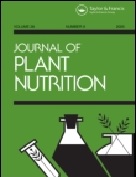Ver ítem
- xmlui.general.dspace_homeCentros Regionales y EEAsCentro Regional Patagonia SurEEA Santa CruzArtículos científicosxmlui.ArtifactBrowser.ItemViewer.trail
- Inicio
- Centros Regionales y EEAs
- Centro Regional Patagonia Sur
- EEA Santa Cruz
- Artículos científicos
- Ver ítem
Above- and below-ground nutrient tissue concentration and leaf pigment changes in Patagonian woody seedlings grown under light and soil moisture gradients
Resumen
To understand the ecophysiology of natural regeneration above- and below-ground nutrient tissue concentration and leaf pigment changes in Nothofagus pumilio (lenga) seedlings grown in three light intensities (4%, 26% and 64% of natural irradiance) and two soil moisture levels (40 –60% and 80 –100% soil capacity) under greenhouse controlled conditions were evaluated. Carbon (C), nitrogen (N), phosphorus (P), magnesium (Mg), potassium (K), calcium (Ca) and
[ver mas...]
To understand the ecophysiology of natural regeneration above- and below-ground nutrient tissue concentration and leaf pigment changes in Nothofagus pumilio (lenga) seedlings grown in three light intensities (4%, 26% and 64% of natural irradiance) and two soil moisture levels (40 –60% and 80 –100% soil capacity) under greenhouse controlled conditions were evaluated. Carbon (C), nitrogen (N), phosphorus (P), magnesium (Mg), potassium (K), calcium (Ca) and pigment (chlorophylls and carotenoids) were measured on seedlings. Carbon, N, Mg, K and Ca increased in low light intensity and soil moisture treatments, while P decreased. Nutrients were
higher in above- than in below-ground biomass. Chlorophylls were lower in high light treatments, while carotenoids increased their content. All pigments were greater in low soil moisture treatments. These changes are closely related to their photosynthetic plasticity and biomass compartmentalization. Plants growing in high light were more efficient to produce the same amount of plant biomass.
[Cerrar]

Autor
Soler Esteban, Rosina Matilde;
Martínez Pastur, Guillermo José;
Lencinas, María Vanessa;
Moretto, Alicia Susana;
Peri, Pablo Luis;
Fuente
Journal of Plant Nutrition 34 : 2222-2236 (2011)
Fecha
2011-10-28
Editorial
Taylor & Francis
Formato
pdf
Tipo de documento
artículo
Palabras Claves
Derechos de acceso
Restringido
 Excepto donde se diga explicitamente, este item se publica bajo la siguiente descripción: Creative Commons Attribution-NonCommercial-ShareAlike 2.5 Unported (CC BY-NC-SA 2.5)
Excepto donde se diga explicitamente, este item se publica bajo la siguiente descripción: Creative Commons Attribution-NonCommercial-ShareAlike 2.5 Unported (CC BY-NC-SA 2.5)

